Subaraj Rajathurai: A Voice for the Wild
A gentle giant with a larger-than-life personality, Subaraj Rajathurai helped to save Singapore’s green spaces.
By Benjamin Ho
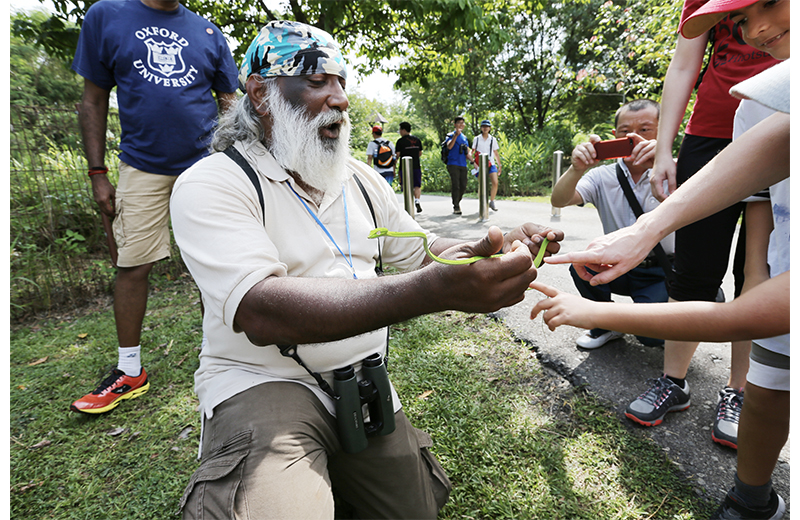
“A remarkable knack [for] spotting animals.” He “worked tirelessly towards the conservation of Singapore’s natural heritage”. It is “a great loss to nature lovers in Singapore”. These were some of the tributes that poured in after news broke that Subaraj Rajathurai, wildlife consultant and nature advocate, had died of a heart attack in October 2019 at the age of 56.1
Subaraj was one of the first personalities I interviewed after joining the Oral History Centre at the National Archives of Singapore. As a nature enthusiast myself, his name frequently cropped up in conversations with fellow nature lovers during field trips I had participated in. However, our paths did not cross until our first meeting in November 2017 at the National Library Building to discuss his oral history interview.
I remember a towering man (at almost 1.8 m tall) with his flowing white hair, long white beard and trademark bandana, who greeted me with a firm handshake. With a warm smile, he introduced me to his wife Shamla. The husband-and-wife team worked together at Strix Wildlife Consultancy – named after a genus of owls – that does research, wildlife surveys, educational outreach programmes, eco-tours and other conservation work. Subaraj loved nature so much that they even named their two sons, Serin and Saker, after a species of finch and falcon respectively. 2
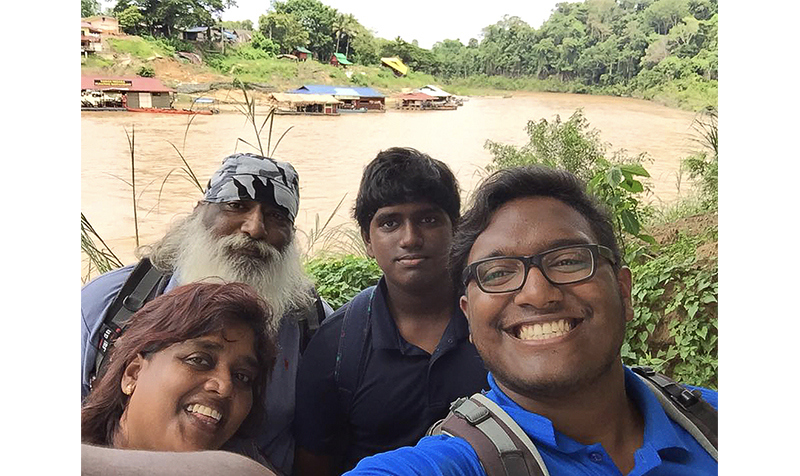
At this meeting, Subaraj told me that he was Singapore’s first licensed tour guide specialising in nature tours. What is even more remarkable about the man was that he was entirely self-taught, honing his craft in the field and following up with research in the library. “I spent four years after National Service, in the field about five days a week, just studying everything about nature. Wandering around places like Bukit Timah and MacRitchie and a whole range of nature areas,” said Subaraj. “[E]verything I encountered, I would write down in a notebook… I would describe it and then I would come right to the National Library – that time in Marine Parade, the branch. And I would sit there for up to three hours, looking at reference books that you can’t borrow and find out the names of everything.”3
Following that meeting, I went on to conduct a series of oral history interviews with Subaraj over six sessions from January to May 2018. He answered my probing questions with authority, yet in an unassuming manner. In his soothing baritone, Subaraj’s love for the wild side of life was apparent. Even before he and his then girlfriend, now wife, got married, he told her that two things would come before her: God (he was a Hindu) and nature.4 At his wake, his wife told The New Paper that family holidays had always revolved around nature, and their flat was filled with pictures of wildlife. “If he could live atop Bukit Timah Hill, he would,” she said.5
I consider it a great privilege to have known Subaraj and to have had the opportunity to document his life story, and capture his memories and his reflections on his work regarding nature conservation in Singapore over almost nine hours of audio recordings.
A Passion for Nature
Back in 1994, long before environmental issues were at the forefront of public consciousness, Subaraj was considered “one of the key figures in the nature movement in Singapore”.6
Born in 1963 to parents who were teachers, Subaraj grew up in a middle-class home in Siglap with an older brother and a younger sister. His initial encounters with wildlife were the insects and birds in his home garden as well as what he saw during his trips to Malaysia to visit relatives. As a child, Subaraj’s hobbies included cutting out animal pictures from magazines and collecting animal wrappers from Milkmaid condensed milk cans. He was inspired by the likes of David Attenborough, Jacques Cousteau, Jane Goodall and David Bellamy as he enjoyed watching their documentaries on television.7
Subaraj studied at Guillemard East Primary School where his father, Rajalingam Rajathurai, was a teacher. (Rajalingam was interviewed by the Oral History Centre in 2003.) Although Subaraj did well enough to go to Raffles Institution, he opted for Tanjong Katong Technical School (now Tanjong Katong Secondary School). After repeating his ‘O’ levels at Siglap Secondary School as he wanted a better certificate, Subaraj enrolled in a private college but this did not work out after he was asked to dissect a live frog.8
After his national service, Subaraj spent most of his time learning about and observing wildlife in their natural habitat, and attending courses conducted by university professors.9 He went on field trips to places like the Endau-Rompin National Park in Johor to learn from experts such as the well-known Malaysian naturalist Dennis Yong. In 1985, Subaraj joined the Nature Society and had the opportunity to take people on guided nature walks.10
Subaraj recalled that his first paid job was in 1988 when he was asked to conduct a tour for foreign bird watchers. “[Taking] people out brought me finally to where I should be because the greatest joy is showing people what you love, enjoying what you love with others and seeing them enjoy it as much as you do,” said Subaraj. “So, taking the bird watchers out, showing them was tremendous. Something that I love and that’s what I wanted to do,” he added.11
Subaraj underwent the Singapore Tourism Board’s six-month tourist guide course and subsequently became the first nature licensed tour guide in Singapore in 1990. He then created and customised all kinds of tours, from general nature walks to hikes, boat rides and bike rides.12 He had designed and conducted more than 50 tours around Singapore.13
Subaraj reckoned that he had taken thousands of people on nature walks to share his knowledge and hopefully win some sympathisers, advocates or activists to the conservation cause. “The more information we share, the better chance we have of saving nature through others having a better understanding and respect for it,” he said.14
Traipsing Up Bukit Timah Hill
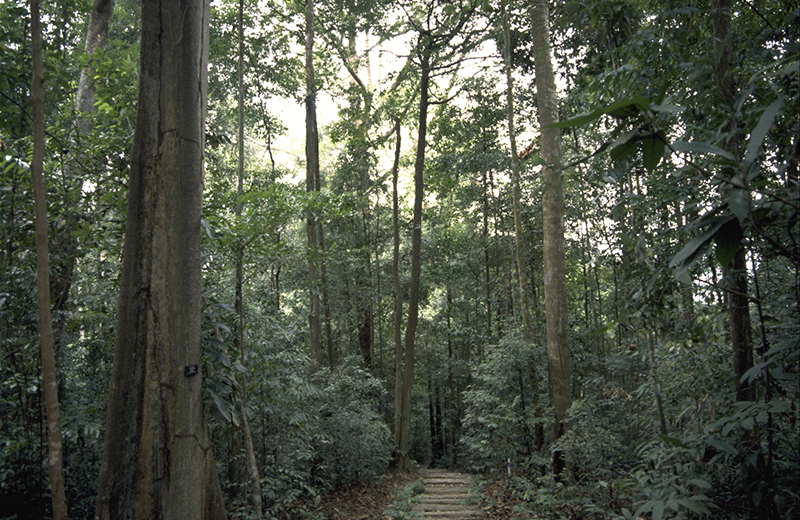
Subaraj’s first trek up Bukit Timah Hill was in the early 1980s when one of his good friends, who lived at the base of the hill, took him there. As soon as he got up the hill, he felt like it was coming home. “I was in a place where I belonged and I never looked back.”15
Back then, Bukit Timah Nature Reserve was a lush, tropical forest, Subaraj said. “And then if it rains, if you go after the rain, it’s like Fraser’s Hill, Cameron Highlands. All mist everywhere, you are walking through a cloud forest like the cloud is sitting there and you are walking through mist, the ground is covered with water”.16 One had to be careful walking around though as “there are giant millipedes everywhere. … [I]f you go in the trails, you have to avoid stepping on the giant millipedes because there are everywhere. You will be killing them”.17
Subaraj’s oral history interview provides a glimpse into how Bukit Timah Hill has changed over time. He observed that the lush vegetation on the hill had become drier. He attributed this to the physical separation of Bukit Timah Nature Reserve and the Central Catchment Nature Reserve by the six-lane Bukit Timah Expressway (BKE). Completed in 1985, the expressway effectively cut the forest reserves into two.18
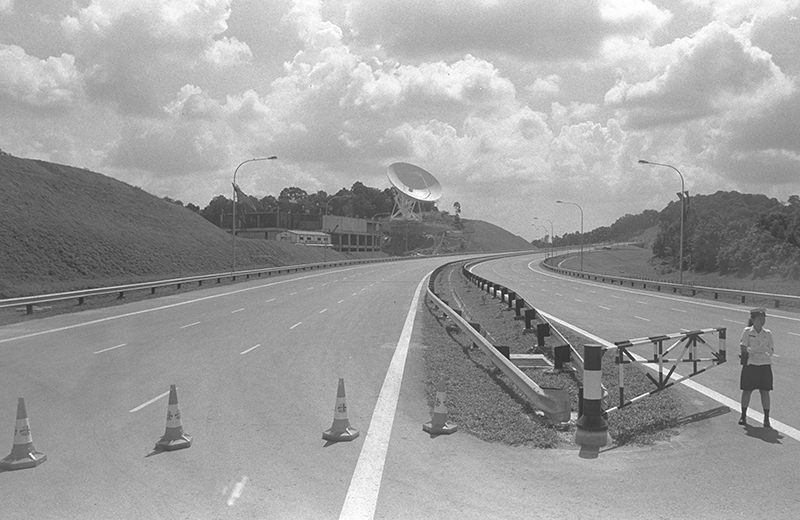
Subaraj recalled that when he first visited Bukit Timah Hill in the early 1980s, “they had just started cutting off Bukit Timah from MacRitchie and Central Catchment with the BKE. So, until then, it was all connected, … after that, from the BKE over the last 30, 40 years, the winds have been blowing, blocking down the trees and drying up the forest”.19
With the construction of condominiums right up to the edge of the hill as well as the building of more roads, Subaraj believed that Bukit Timah Nature Reserve was suffering. “I have been fighting a battle to try and save this hill but the preoccupation is there are people who just want to treat it like a park,” he lamented.20
He recalled a time when Bukit Timah Hill was under the radar of most people. “So, most of the time… I probably had the hill to myself the whole day. I don’t meet a single soul.”21 The turning point, according to Subaraj, was the release of a three-part documentary series in 1993 titled Bellamy’s Singapore, hosted by the renowned botanist and conservationist David Bellamy. (Subaraj had been the natural history consultant for the programme.22) Because of concerns among the nature community that the large numbers of visitors would damage the natural heritage of Bukit Timah Hill, Subaraj said that he stopped conducting tours there.23
Nature conservationists were also worried that the isolation of the flora and fauna at the Bukit Timah Nature Reserve from the much larger Central Catchment Nature Reserve would adversely affect biodiversity and threaten the survival of plants and animals.24 Finally, in 2013, a 50-metre-wide green corridor known as Eco-Link@BKE was built to allow wildlife to safely cross from one forest tract to the other.25
In September 2014, Bukit Timah Nature Reserve was closed for two years for repair and restoration works to its slopes, trails and forests.26 That, and the earlier opening of Dairy Farm Nature Park in September 2009, helped draw some human traffic away from Bukit Timah Hill which alleviated the pressure on the wildlife there.27
The Allure of Pulau Ubin
Subaraj was also closely associated with Pulau Ubin, a small island located off the northeastern shore of mainland Singapore. He had conducted many tours on Pulau Ubin, which he described as a “very nice, thriving community, kampong community” with “very friendly people”, and akin to “visiting Malaysia without your passport”.
“It’s like a different world. You step into a different time, more relaxed. If you go on a weekday to Pulau Ubin and you sit down quietly at the coffee shop and have a cup of coffee, I promise you, your stress will disappear, and you go into this very relaxed feeling,” he said.28
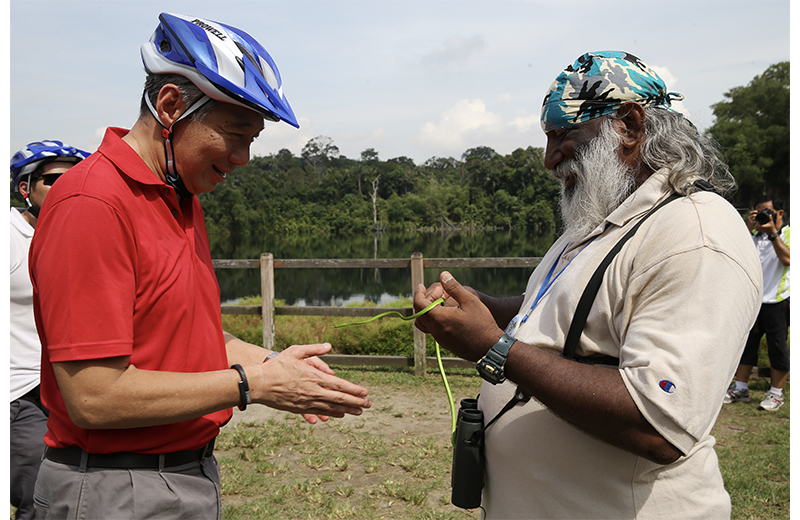
In his oral history interview, Subaraj also talked about the local community on the island and the way they organised themselves. In the 1980s, there were a few thousand people living in villages scattered across the island, with a headman for each village. “That means each member of that council of elders was the headman of one village, led by the main headman of Pulau Ubin, and they made all the decisions for the islands.” Whenever the government wanted to do something on Ubin, the ministers would seek advice from the council of elders first.29
Subaraj remembered taking visitors to the main headman’s house and showing them the exotic pets that he kept. He recalled: “I knew him well. He used to have one bad habit and that was he liked to catch some of the local wildlife and keep in a mini zoo in his garden so [he] had a civet cat and a flying fox…”30
Protecting Sungei Buloh
Subaraj was also involved in the effort to protect and preserve the natural environment at Sungei Buloh. Quietly nestled in the northwestern corner of Singapore, Sungei Buloh was a mangrove forest and farming area when avid birdwatcher Richard Hale discovered it in 1986. He found that it was rich with birdlife and spread the word to the rest of the nature community here.
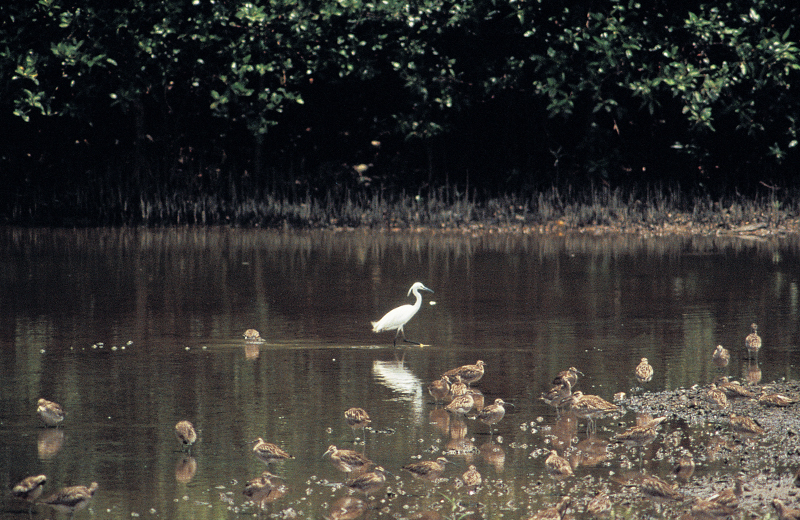
Subaraj recalled: “So [Richard] was wandering around on his own in this area, and he stumbled upon this place where he came across from one side of the river looking across and seeing all these birds flying around… these migratory shore birds from Russia and Siberia and all.”31
Sungei Buloh was originally earmarked for development as an agro-technology park. In December 1987, Subaraj,32 Hale and a few members of the Nature Society put forth a proposal for the creation of a 318-hectare nature reserve in Sungei Buloh.
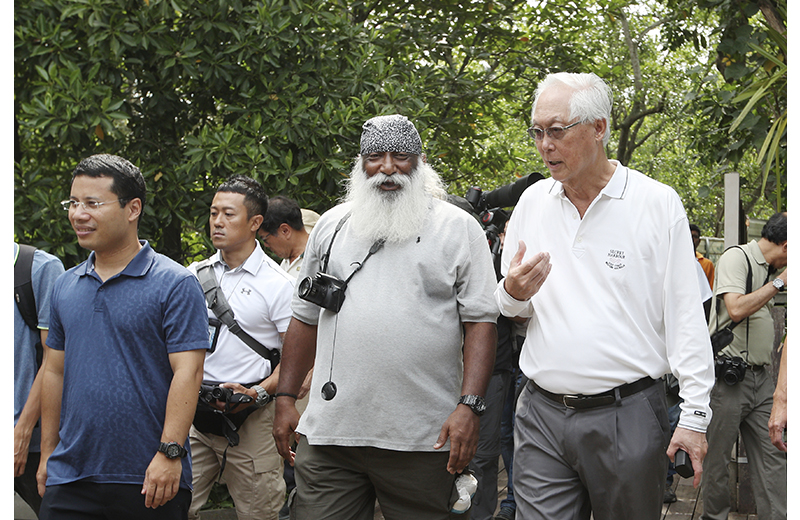
“We sat down for eight months and wrote a proposal for Sungei Buloh based on whatever we know about the place, the research, the information, the potential value in the future for education and tourism and all that,” recalled Subaraj. The proposal was sent to the government, including Prime Minister Lee Kuan Yew and President Wee Kim Wee. The latter also paid a visit to the site.
Subaraj was initially skeptical that the effort would be a success. “[W]hen [Richard] brought [Sungei Buloh] to our attention, initially there was doubt as to whether this is worth going for because so many doors have been slammed. No area had been conserved since the British left since independence. But this area had one thing going for it, that is the future for it was agro-tech farming. Not housing, not schools, not a reservoir but agro-tech farming which was not so high [a] priority.”33
The proposal was accepted by the Ministry of National Development and on 8 April 1988, National Development Minister S. Dhanabalan announced that 85 ha of land in Sungei Buloh would be preserved for a bird sanctuary. This marked the first time since independence that land had been set aside for nature conservation in Singapore.34 It was also the first time that a civil society group had successfully convinced the government to change its plans.35
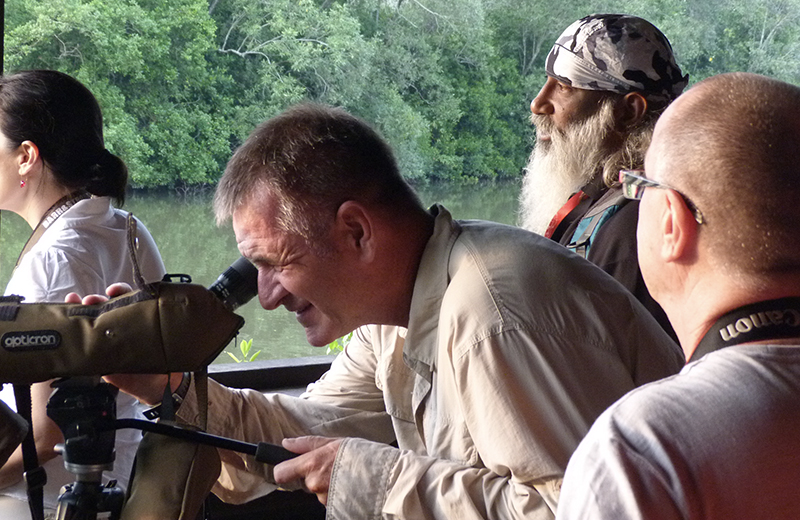
Subaraj and the group of birdwatchers were subsequently involved in the setting up of the fledging bird sanctuary. “We had a say in the matter, even in the design, because when they were designing Sungei Buloh, they brought in a specialist from England, from Slimbridge who are specialists in water birds, but they are not specialists in shore birds which is this place, so we came in and gave the information from behind the scenes.”36
Sungei Buloh Nature Park was officially opened by Prime Minister Goh Chok Tong in December 1993.37 It was officially gazetted as a nature reserve in 2002 and renamed Sungei Buloh Wetland Reserve. It became Singapore’s first ASEAN Heritage Park in 2003.
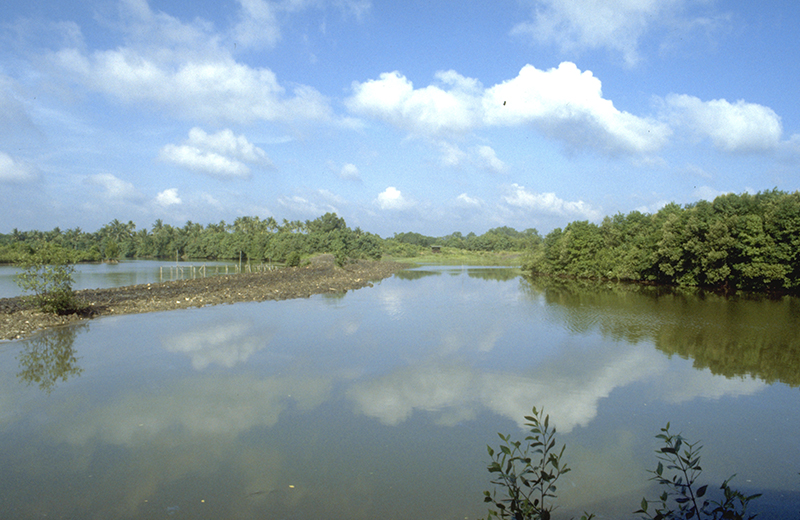
Subaraj attributed its success to the hard work of the National Parks Board (which manages the place today), the nature community and volunteers, who replanted mangroves, protected the habitats and carried out research. “[Sungei Buloh] became a key education stop for students from all over, and it became recognised as that very key stop for migrating birds from Siberia to Australia… we work with all the different countries on the passage, to make sure there is passage for the birds, feeding areas for the birds.”38
Subaraj also cited the re-emergence of predator species such as the otter and saltwater crocodile as a validation of the successful reforestation of the mangrove habitat. These predators are important for any healthy ecosystem as they control the population of the prey species. “First the otters, then the crocodiles,” said Subaraj. “And when they are there, it indicates that this works, this ecosystem works.”39
Subaraj was proud to have been involved in the process of conserving Sungei Buloh since day one. He said: “It’s one of the few places in Singapore where I can go there and say, ‘So here!’ and it’s better than ever before.”40
A Legacy to Remember
In 2018, Subaraj was able to look back with satisfaction at his work in protecting the natural environment in Singapore. “Sungei Buloh is now well-known worldwide, as is Pulau Ubin [and] Bukit Timah. And the Internet has made the world smaller, so people can read about it.”41
Subaraj had also worked on various environmental impact assessments, wildlife surveys and field studies in the 1990s such as Lower Peirce Reservoir where 123.8 ha of forest were saved. In 1990, he was involved in drafting the Master Plan for the Conservation of Nature in Singapore, which recommended a number of sites for conservation, including the mangroves in Mandai.42
He was also part of a working group of nature experts consulted by the Land Transport Authority regarding the upcoming Cross Island MRT Line and its impact on wildlife as this line could potentially tunnel under the Central Catchment Nature Reserve.43 In addition, Subaraj helped to draft the proposed amendments to the Wild Animals and Birds Act; the bill was passed in Parliament in March 2020.44
Subaraj’s death came as a shock to all. He had suffered a heart attack while having an afternoon nap on 22 October 2019. At his funeral the following day, dozens of people from the nature community came dressed in green to pay their respects. Speaking at his funeral, Subaraj’s wife said: “The community will have to band together. They know what Subaraj was fighting for, and they will continue to fight for him.”45
Subaraj’s name will live on in the form of a tiny frog species recently discovered in Singapore. Subaraj’s Paddy Frog (Micryletta subaraji) is a greyish-brown amphibian, barely larger than a marble, that was first sighted along Old Upper Thomson Road in 2019. Sankar Ananthanarayanan, president of the Herpetological Society of Singapore, was one of the researchers who helped to establish that the frog belonged to a unique species and thus needed a name.
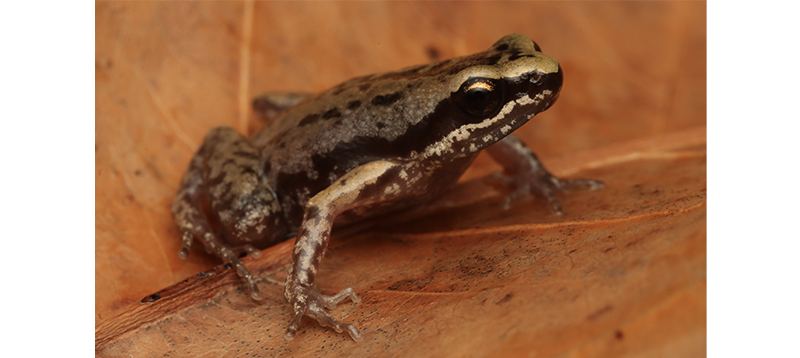
In an interview with the Straits Times in August 2022, Sankar noted that many places and wildlife in the region are named after colonial-era figures such as Stamford Raffles and Alfred Russel Wallace. “It is only recently that regional scientists and amateur naturalists have become more prominent, so we wanted to name the frog after Subaraj, who was as much an inspiration to us as any of these other naturalists.”46
 Benjamin Ho is a Specialist with the Oral History Centre, National Archives of Singapore. His work involves developing the oral history collection, conducting workshops on oral history and disseminating oral history.
Benjamin Ho is a Specialist with the Oral History Centre, National Archives of Singapore. His work involves developing the oral history collection, conducting workshops on oral history and disseminating oral history.NOTES
-
Janice Lim and Low Youjin, “‘Gentle Giant’ and Iconic Conservationist Subaraj Rajathurai Dies,” Today, 22 October 2019, https://www.todayonline.com/singapore/gentle-giant-and-iconic-conservationist-subaraj-rajathurai-dies; Malavika Menon, “PM Lee Hsien Loong Pays Tribute to Singapore’s ‘Nature Man’ Subaraj Rajathurai,” Straits Times, 6 November 2019, https://www.straitstimes.com/singapore/pm-lee-pays-tribute-to-singapores-nature-man-subaraj-rajathurai. ↩
-
Venessa Lee, “At Home with Nature,” Straits Times, 20 February 2017, 1. (From NewspaperSG) ↩
-
Subaraj Rajathurai, oral history interview by Benjamin Ho, 9 January 2018, transcript and MP3 audio, Reel/Disc 1 of 10, National Archives of Singapore (accession no. 004236), 16–17. ↩
-
Lim and Low, “‘Gentle Giant’ and Iconic Conservationist Subaraj Rajathurai Dies”; Lee, “At Home with Nature.” ↩
-
Kok Yufeng, “Veteran Nature Guide, Conservationist Subaraj Rajathurai Dies Aged 56,” The New Paper, 23 October 2019, https://tnp.straitstimes.com/news/singapore/veteran-nature-guide-conservationist-subaraj-rajathurai-dies-aged-56. ↩
-
Leong Siew Lin, “Doing What Comes Naturally, That’s Sparrowhawk Subaraj,” Nature Watch (July–September 1994): 27. (From National Library, Singapore, call no. RSING q508.5957 NW) ↩
-
Subaraj Rajathurai, interview, 9 January 2018, Reel/Disc 1 of 10, 2, 9. ↩
-
Subaraj Rajathurai, interview, 9 January 2018, Reel/Disc 1 of 10, 12, 14, 16. ↩
-
Subaraj Rajathurai, interview, 9 January 2018, Reel/Disc 1 of 10, 17. ↩
-
Lee, “At Home with Nature.” ↩
-
Subaraj Rajathurai, interview, 9 January 2018, Reel/Disc 1 of 10, 18, 19. ↩
-
Lee, “At Home with Nature”; Subaraj Rajathurai, interview, 9 January 2018, Reel/Disc 1 of 10, 19, 20; “Subaraj Rajathurai,” Strix Wildlife Consultancy, accessed 30 September 2022, https://www.subaraj.com/www.subaraj.com/index.html. ↩
-
Lim and Low, “‘Gentle Giant’ and Iconic Conservationist Subaraj Rajathurai Dies.” ↩
-
Lee, “At Home with Nature.” ↩
-
Subaraj Rajathurai, interview, 9 January 2018, Reel/Disc 1 of 10, 20, 21; Lee, “At Home with Nature.” ↩
-
Subaraj Rajathurai, interview, 9 January 2018, Reel/Disc 1 of 10, 20, 21. ↩
-
Subaraj Rajathurai, interview, 9 January 2018, Reel/Disc 1 of 10, 21. ↩
-
Lee Meiyu and Fiona Lim, “Bukit Timah Nature Reserve,” in Singapore Infopedia. National Library Board Singapore. Article published 19 November 2015. ↩
-
Subaraj Rajathurai, interview, 9 January 2018, Reel/Disc 1 of 10, 21, 22. ↩
-
Subaraj Rajathurai, interview, 9 January 2018, Reel/Disc 1 of 10, 21, 22. ↩
-
Subaraj Rajathurai, oral history interview by Benjamin Ho, 9 January 2018, transcript and MP3 audio, Reel/Disc 2 of 10, National Archives of Singapore (accession no. 004236), 34. ↩
-
Leong, “Doing What Comes Naturally,” 27. ↩
-
Subaraj Rajathurai, oral history interview by Benjamin Ho, 28 May 2018, Reel/Disc 10 of 10, National Archives of Singapore (accession no. 004236), 199. ↩
-
Irene Hoe, “Is the Bukit Timah Nature Reserve Dying Slowly?” Straits Times, 24 March 1985, 3. (From Newspaper SG) ↩
-
“NParks Starts New Guided Walks of Eco-Link@BKE,” National Parks Board, 4 November 2015, https://www.nparks.gov.sg/news/2015/11/nparks-starts-new-guided-walks-of-eco-link-at-bke. ↩
-
“Bukit Timah Nature Reserve Restoration Works – Limited Access to Ensure Public Safety,” National Parks Board, 1 June 2014, https://www.nparks.gov.sg/news/2014/6/bukit-timah-nature-reserve-restoration-works-limited-access-to-ensure-public-safety. ↩
-
Grace Chua, “Look Out for Rare Bird at New Park,” Straits Times, 6 September 2009, 2. (From Newslink via NLB’s eResources website) ↩
-
Subaraj Rajathurai, oral history interview, 9 January 2018, Reel/Disc 2 of 10, 34, 45. ↩
-
Subaraj Rajathurai, oral history interview, 9 January 2018, Reel/Disc 2 of 10, 44. ↩
-
Subaraj Rajathurai, oral history interview, 9 January 2018, Reel/Disc 2 of 10, 44. ↩
-
Subaraj Rajathurai, oral history interview by Benjamin Ho, 16 January 2018, transcript and MP3 audio, Reel/Disc 3 of 10, National Archives of Singapore (accession no. 004236), 56. ↩
-
Lee Swee Hoon, “Bird Lovers Submit Proposals for 300-ha Nature Reserve,” Straits Times, 14 December 1987, 14. (From NewspaperSG); [Subaraj Rajathurai] (https://www.nas.gov.sg/archivesonline/flipviewer/publish/0/00dba138-4db9-11e8-b81e-001a4a5ba61b-OHC004236003/web/html5/index.html?launchlogo=tablet/OralHistoryInterviews_brandingLogo.png), oral history 16 January 2018, Reel/Disc 3 of 10, 56–57. ↩
-
Subaraj Rajathurai, oral history 16 January 2018, Reel/Disc 3 of 10, 56. ↩
-
Janice Loo, “Sungei Buloh Wetland Reserve,” Singapore Infopedia, published 31 December 2015; Subaraj Rajathurai, “The Man Behind Sungei Buloh,” Straits Times, 16 August 2015, 6; Wing Chong, “Volunteers’ Efforts Helped Save Sungei Buloh,” Straits Times, 23 August 2015, 6. (From NewspaperSG) ↩
-
Lee, “At Home with Nature.” ↩
-
Subaraj Rajathurai, oral history 16 January 2018, Reel/Disc 3 of 10, 57. ↩
-
“Govt Committed to Nature Conservation,” Straits Times, 7 December 1993, 1. (From NewspaperSG) ↩
-
Subaraj Rajathurai, oral history 16 January 2018, Reel/Disc 3 of 10, 58. ↩
-
Subaraj Rajathurai, oral history 16 January 2018, Reel/Disc 3 of 10, 58. ↩
-
Subaraj Rajathurai, oral history 16 January 2018, Reel/Disc 3 of 10, 58, 59. ↩
-
Subaraj Rajathurai, oral history 16 January 2018, Reel/Disc 3 of 10, 59. ↩
-
Lim and Low, “‘Gentle Giant’ and Iconic Conservationist Subaraj Rajathurai Dies”; Lee, “At Home with Nature.” ↩
-
“Cross Island Line Site Investigations Haven’t Driven Away Rare Animals from Nature Reserve, Says LTA,” Today, 9 June 2018, https://www.todayonline.com/singapore/cross-island-line-site-investigations-havent-driven-away-rare-animals-nature-reserve-says. ↩
-
Audrey Tan, “Parliament: More Protection for Native Wildlife, Harsher Penalties for Offenders Under Amended Law,” Straits Times, 25 March 2020, https://www.straitstimes.com/politics/parliament-more-protection-for-native-wildlife-harsher-penalties-for-offenders-under. ↩
-
Audrey Tan, “Dozens from Nature Community Turn Up in Green in Final Farewell to Wildlife Consultant Subaraj Rajathurai,” Straits Times, 25 October 2019, https://www.straitstimes.com/singapore/environment/dozens-from-nature-community-turn-up-in-green-in-final-farewell-to-late. ↩
-
Ang Qing, “New Frog Species Discovered in Singapore for 1st Time in Nearly 40 Years,” Straits Times, 8 August 2022, https://www.straitstimes.com/singapore/environment/new-frog-species-discovered-in-singaporefor-1st-time-in-nearly-40-years. ↩

